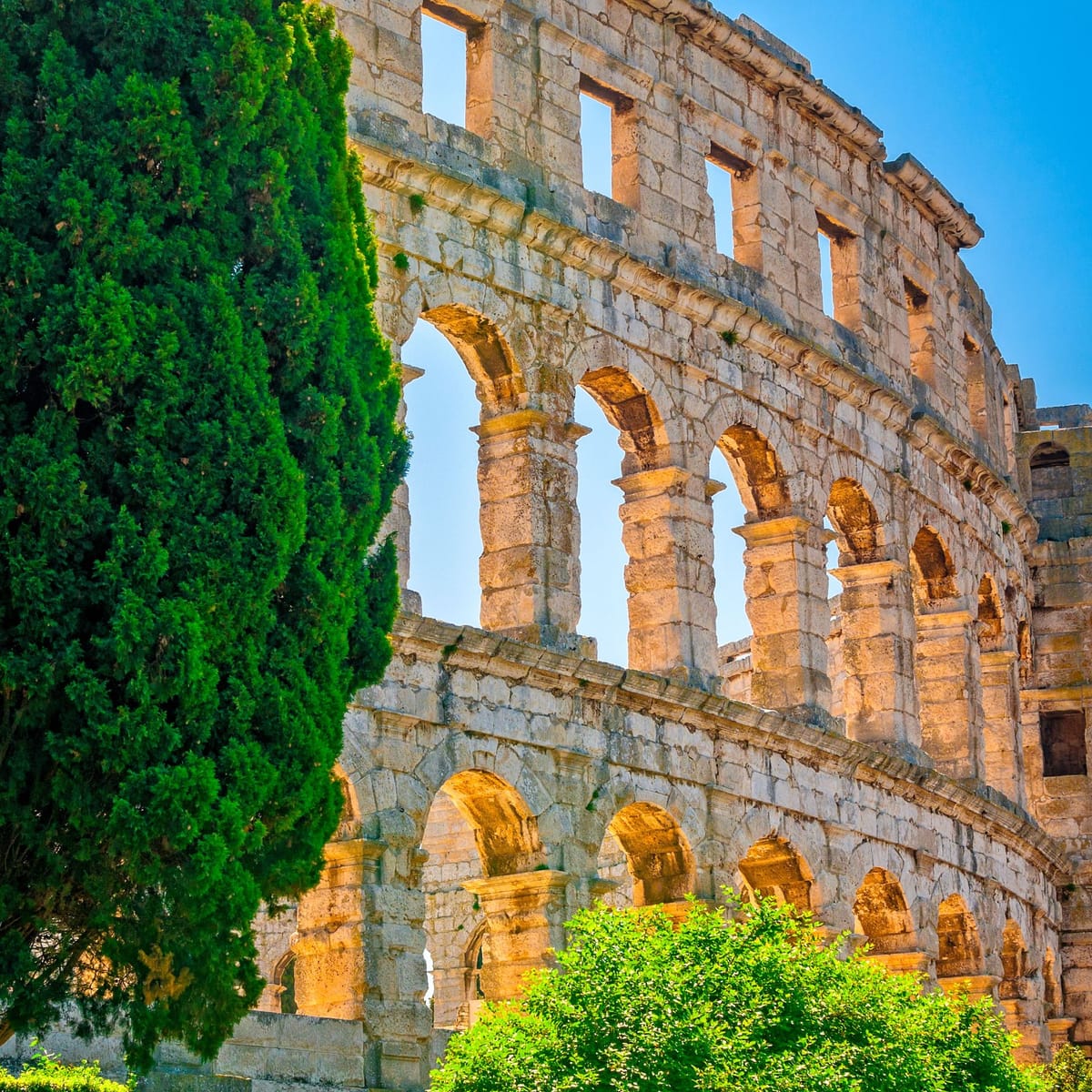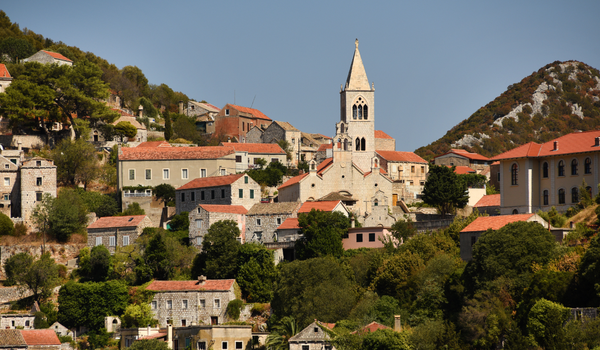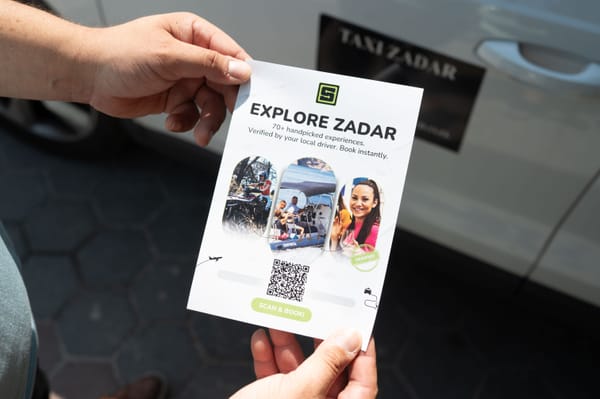Best things to do in Pula (Travel guide)
Are you a history buff in love with Roman culture? This guide to things to do in Pula will help you plan a perfect visit to this history-rich city.

Craving history, sun, and sparkling Adriatic waters? Look no further than Pula, Croatia. This charming coastal town on the tip of the Istrian Peninsula offers a captivating blend of ancient Roman ruins, stunning beaches, and a vibrant atmosphere.
Where is Pula, exactly?
If you head out to the southern tip of the Istrian Peninsula, Croatia, you’ll discover the coastal town bustling with life and history. Welcome to Pula.
What are some things to do in Pula?
With one of the world's largest and most complete Roman amphitheatres, Pula is your best alternative to time travel in Istria.
Or uncover one of Pula’s picturesque beaches with crystal clear and turquoise sea. Perfect to kick back and relax on your holiday.
What else?
Here’s what you should know before visiting Pula — the largest town in Istria.
History of Pula
Nations that conquered Pula, epidemics, wars, and time itself shaped the identity of this historical Croatian city into what we can visit and see today.
Pula’s rich history goes back over 3,000 years. Here is a quick rundown:
- In the 2nd century BCE, Pula was conquered by Rome. It became a religious centre and the city got the Forum, sewage system and major monuments.
- In the 17th century, the plague decreased the population to less than a hundred.
- At the end of the 18th century, Austria claimed Pula and turned it into one of their main harbours and military forces. Trenches, tunnels, and forts built in the Austro-Hungarian era are still there today.
- In 1920, Pula became a part of Italy.
- In 1947, Pula was recognized as part of Croatia (at the time still part of Yugoslavia).
Fast forward to today, Pula is one of the most important ports and popular tourist locations in Croatia. Visitors from all over the world come to walk the city and discover some of the most preserved artefacts and structures dating to the Roman Empire.
Best Time of Year to Visit Pula
Most visit Pula in the summer (June–September) to cool off in the Adriatic Sea and explore the historical city during their holiday. In July, the hottest month of the year, the maximum temperatures can reach mid-30s°C.
Between September and November is the off-peak tourist season. Hotel stays are cheaper and the city is less crowded with visitors, but flights and ferry lines are scarce. Perfect for Roman history enthusiasts who want to explore the city on foot (minus the summer heat).
How to Travel to Pula
Depending on your starting point and season, your best options to travel to Pula, Croatia are a plane, boat, bus or car.
If you visit in summer, you can book a flight to Pula, Croatia from major European cities — including Paris, Amsterdam, London, Zagreb and Berlin. Look up lines that lead directly to the Pula airport (PUY).
Another seasonal option is to travel by ferry. In summer, you can reach Pula from Italy, the surrounding island, or several coastal Croatian towns (e.g. Zadar).
If you travel to Pula from the inland part of Croatia that is well connected with roads, you can take a scenic ride by bus or rent a car. For example, there are a lot of bus lines that take you from Zagreb to Pula in about four to five hours.
Visit the Historical Sites of Pula
Pula used to be fortified by walls. By the 19th century, they were torn down by wars and conquests. The only remnants of once grand stone walls you can see today are two gates still standing today (the Gate of Hercules and the Twin Gates).
If you take a Pula walking tour, these are the main attractions, Croatia's historical sites, and monuments built and protected within these walls that you can still see these days.
Arena Pula (Roman Colosseum)
Built over the 1st century AD, the Arena in Pula, Croatia is the 6th grandest and one of the best-preserved Roman amphitheatres in the world.
The structure could host around 23,000 people to watch battles, gladiator games or mediaeval knight tournaments. Over time, the parts were repurposed (read stolen) to make other structures in the city.
Today, this famous Arena overlooking the sea can comfortably fit 5,000 people and it’s used for concerts.
Forum
The Forum (or city square) in Pula has been the centre of ancient, mediaeval, and contemporary Pula. If you look around, you can spot the City Hall and different Roman monuments.
The main square hosts any larger, important events that take place in the city.
Out of five temples built as part of the Forum in the 1st century BCE (all dedicated to gods), the only one still standing is the Temple of Augustus.
Temple Of Augustus
Preserved in its original glory for over 2,000 years, the Temple of Augustus is another remnant of the Roman era that you can see gracing the Forum square today.
The temple is dedicated to the goddess Roman and the Emperor Augustus.
How come it’s still complete? It was reused as a church when Romans adopted Catholicism and later converted into a granary.
Cathedral Of The Assumption Of The Holy Virgin
The minimalist, yet beautiful and grand design of the Cathedral of the Assumption of the Blessed Virgin Mary is a sight to see.
It was built between the 4th and 5th centuries, initially to serve the growing number of Christians in the area.
Over time, it has been transformed, restored, and reimagined. Its complex history is mirrored in its blend of different architectural styles.
Many visitors watch the sunset from the bell tower with the panoramic view of the city. The best time to visit the cathedral is early in the morning or late afternoon.
Triumphal Arch of the Sergii
The Triumphal Arch of the Sergii (also known as the Golden Gate of Pula) was built around 30 BCE.
The influential Sergii family commissioned the arch to commemorate three noblemen of their family who fought in the naval Battle of Actium (think Antony & Cleopatra).
Pula Kaštel (Castle)
The “Kaštel” fortress dates back to the 17th century. It has been used to defend the Pula harbour, bay and the inner city ever since.
The structure is shaped like a flower and placed strategically on the hill. If you have an interest in the military (or enjoy scenic views), check out watchtowers, cannons, and the History Museum within the castle.
Roman Theatre
The ruins of the small Roman theatre haven’t been as well preserved as the big Arena has. All that is left to see now is a small chunk of the viewing area, but back in the day, it used to hold an impressive 5,000 spectators.
This small piece of the Roman past provides an intimate insight into historical entertainment. If you were there in the 1st century AD, you could watch the performers retell the myths and legendary tales in this iconic theatre.
Other Activities to Try in Pula
What can you do after visiting the top historic landmarks in Pula? Cuisine, national parks, concerts, and museums provide deeper insight into Istrian culture and tradition.
We selected a few activities for foodies, those with adventurous spirits, music lovers, history buffs and marine life enthusiasts.
Book a Food Tasting Tour
Want to get to know the rich culinary history and tradition of Pula through food and wine? Friendly locals can guide you on a tasty tour where you’ll sample famous Istrian specialities, get to know hidden gems of the area and learn a lot about local cuisine and customs.
From group walks & food tours to small private food-tasting tours, book what works best for you. Pula has plenty of wine and food-tasting tours to explore.
Try a Cooking Class
Do you want to learn how to prepare fish and learn the well-kept secrets behind traditional Istrian recipes from the locals?
Interested in vegetarian and vegan classes, those teaching you to prepare fish, fresh pasta, Istrian ravioli, meals with truffles, or other authentic Croatian recipes?
Reserve your place at one of many available cooking classes in Pula.
Take a Boat Trip to Nearby Islands
If you want to explore beyond Pula’s archaeological remnants, you can always go island hopping, kayaking, diving, snorkelling, dolphin spotting or cliff jumping.
Around Pula, there are sea caves, scenic islands, and an underwater world waiting to be discovered.
Book a boat tour to explore Pula and uncover the natural beauty of the surrounding area from the sea. One of the most popular boat tours leads you to Brijuni National Park.
Go to a concert in the Pula Arena
Outdoor concerts in the former Roman amphitheatre by the sea will elevate your concert experience.
The Arena in Pula provides centre stage for renowned musicians from all over the globe. Many artists graced its stage — including Lenny Kravitz, Robbie Williams, Florence and the Machine, Duran Duran and Dua Lipa.
Check the future lineup to spot your favourite artist. And don’t forget to book your ticket in advance because they sell out fast.
Visit a Museum in Pula
Here is the list of top museums that you can visit in Pula:
- Contemporary Art Museum of Istria
- The Sacred Heart Museum
- The Archaeological Museum of Istria
- Istrian Olive Oil Museum
- Memo Museum of Good Memories
Beyond museums, there are also art galleries and different collections.
Check Out Fish and Turtles in the Pula Aquarium
Find the Pula Aquarium within the walls of the former Austro-Hungarian fortress called Verudela.
Besides the unique setting, the aquarium has over 100 fish tanks in which you can identify over 250 kinds of marine species (from those native to Croatia and the Adriatic Sea to tropical and freshwater fish).
Also, this is the only turtle rescue centre in Croatia.
Best Beaches in Pula
Pula is set on the beautiful seafront. However, since this is an industrial town, part of the coast is taken up by shipyards and harbours not suitable for swimming and bathing.
If you want to sunbathe and swim in the sea, head out to one of these top five beaches in Pula:
- Ambrela Beach — this pebbled beach is the most popular one in Pula and it isn’t far from the historical city centre
- Hawaii Beach — this small and quaint beach nestled in the cove is perfect for snorkelling in the clear blue sea and exploring with transparent kayaks
- Saccorgiana (aka Zeppelin Beach) beach — this is a local favourite pebbly beach with a bar and playground nearby that is also pet friendly
- Valkane beach — this is a popular city beach, mostly concrete, with easy access to the sea and lots of shade
- Pješčana uvala (aka Sandy Bay) — best for families with children because of the blend of sand and pebbles that are more gentle for feet
Some of the best Pula beaches are in the southern part of the city, often a short drive away from the old town. You can reach them by city bus or car.
Best Restaurants in Pula
Istrian cuisine has its own history to tell — whether it’s meticulously plated in a Michelin-approved restaurant or made with love in the small local tavern.
Where can you grab a bite to eat in Pula?
Best Fine Dining Restaurants
While there are Michelin-star awarded restaurants in Istria, you won’t find one in Pula. Still, there are many top places for fine dining in Istria.
We handpicked three top options that provide the best food and customer service while taking you on a culinary journey.
Salon 1875
Fine dining in Salon 1875 means homemade meals, authentic dishes made with local produce and catch of the day — brought to you by attentive staff.
From morning coffee to the night cocktail with specialities such as pasta with truffles, this restaurant placed on the Forum serves all your foodie needs.
Also, the restaurant offers vegan options.
Ribarska Koliba
Ribarska koliba (aka Fisherman’s Hut) is the closest alternative to the Michelin restaurant in Pula. In fact, this fine dining restaurant earned a “Michelin plate” — meaning the Michelin reviewer approved the food.
The restaurant with the sea view specialises in seafood recipes prepared with the freshest locally sourced ingredients, offering tradition with a modern twist.
The Michelin guide recommends you to try the bouillabaisse.
Farabuto
Offering high-quality Mediterranean and traditional Istrian food, this small restaurant is a hidden gem in Pula.
The restaurant caters to versatile dietary needs. For example, it provides gluten-free and vegetarian options.
Best Budget Restaurants
From local taverns, and pizza places, to fast-food restaurants, you have a lot of options in Pula.
Piantina Fine Fast Food
This fast food restaurant is great if you want a more homely take on fast food staples such as burgers and fries. You can also order grilled sandwiches and cold drinks to cool off in the summer.
There are available vegetarian options too.
Kod Kadre
“Kod Kadre” is a traditional tavern that serves predominantly meat-based traditional Croatian food. The menu is versatile and offers everything from meat platters, fries, čevapi, gnocchi, and goulash.
It’s a short walk from the Pula’s Arena.
TiVoli
ToVoli is a budget-friendly restaurant in Pula that serves a wide range of light Mediterranean meals and Italian staples such as pizzas and pasta meals.
It provides great value for the price and high-quality food made with fresh and locally sourced ingredients.
Where to Stay in Pula
Apartments, hostels, hotels, or camping are the most popular options for a stay in Pula.
The closer to the historical city centre and coastline, the pricier the accommodation. Therefore, if you rent a car, you can find more affordable options (and explore the surrounding cities in Istria).
Pro Tip: Book your accommodation ahead of the trip directly or via third-party sites such as Airbnb or Booking.com.
Private Apartments
Price-wise, apartments are the middle ground between hotels and hostels (unless you book a luxury villa). They provide the most privacy and have all you need to rest, relax, and cook your own meals.
Hostels
Hostels are your best option for budget-friendly travel. They’re cheap and a great opportunity to meet new people who are on similar journeys as you are.
Hotels
From the luxury hotels placed on the coastline to charming boutique hotels, you have a lot of options in Pula.
Other Common Questions About Visiting Pula
These are the Frequently Asked Questions (FAQ) that tourists ask us when planning their trip to Pula.
Is Pula Worth Visiting?
Yes, absolutely. Between its rich history, Roman ruins, scenic beaches, and museums, there is a lot to experience in Pula.
Is Pula safe to visit?
Generally, Pula is a safe town to visit in Croatia, but be cautious if you travel alone.
How Many Days Do You Need in Pula?
You can see the main historical landmarks in a day, but the optimal days for a complete experience is 3 to 4 days.
Thinking of Visiting Pula, Croatia? Start Here
Don't just dream of Croatian sunshine, dive into it.
Book a flight, or bus as well as accommodation. Pack some comfortable shoes and seasonal clothing.
Pula awaits with its Roman wonders, sparkling beaches, and endless charm. This vibrant town offers something for everyone – history buffs can wander ancient ruins, beach lovers can soak up the Adriatic sun, and adventurers can explore hidden coves by boat.
Indulge in fresh seafood, lose yourself in local festivals, or simply relax on the shore with a good book.
Pula is your gateway to an unforgettable Istrian escape. Book your trip today.





